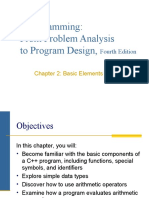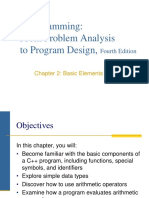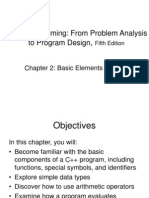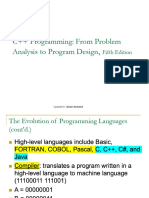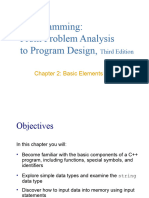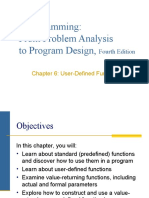0 ratings0% found this document useful (0 votes)
1K viewsC++ Programming: From Problem Analysis To Program Design
C++ Programming: From Problem Analysis to Program Design, Fifth Edition
Chapter 8: Namespaces, the class string, and User-Defined Simple Data Types
Objectives
In this chapter, you will: Learn how to create and manipulate your own simple data type called the enumeration type Become familiar with the typedef statement Learn about the namespace mechanism Explore the string data type and learn how to use the various string functions to manipulate strings
C++ Programming: From Problem Analy
Uploaded by
Nishantha Pushpa KumaraCopyright
© Attribution Non-Commercial (BY-NC)
Available Formats
Download as PPT, PDF, TXT or read online on Scribd
0 ratings0% found this document useful (0 votes)
1K viewsC++ Programming: From Problem Analysis To Program Design
C++ Programming: From Problem Analysis to Program Design, Fifth Edition
Chapter 8: Namespaces, the class string, and User-Defined Simple Data Types
Objectives
In this chapter, you will: Learn how to create and manipulate your own simple data type called the enumeration type Become familiar with the typedef statement Learn about the namespace mechanism Explore the string data type and learn how to use the various string functions to manipulate strings
C++ Programming: From Problem Analy
Uploaded by
Nishantha Pushpa KumaraCopyright
© Attribution Non-Commercial (BY-NC)
Available Formats
Download as PPT, PDF, TXT or read online on Scribd
You are on page 1/ 46
C++ Programming: From Problem
Analysis to Program Design, Fifth Edition
Chapter 8: Namespaces, the class
string, and User-Defined
Simple Data Types
Objectives
In this chapter, you will:
• Learn how to create and manipulate your own
simple data type called the enumeration type
• Become familiar with the typedef statement
• Learn about the namespace mechanism
• Explore the string data type and learn how
to use the various string functions to
manipulate strings
C++ Programming: From Problem Analysis to Program Design, Fifth Edition 2
Enumeration Type
• Data type: a set of values together with a
set of operations on those values
• To define a new simple data type, called
enumeration type, we need three things:
– A name for the data type
– A set of values for the data type
– A set of operations on the values
C++ Programming: From Problem Analysis to Program Design, Fifth Edition 3
Enumeration Type (cont'd.)
• A new simple data type can be defined by
specifying its name and the values, but
not the operations
– The values must be identifiers
• Syntax:
– value1, value2, … are identifiers called
enumerators
– value1 < value2 < value3 <...
C++ Programming: From Problem Analysis to Program Design, Fifth Edition 4
Enumeration Type (cont'd.)
• Enumeration type is an ordered set of
values
• If a value has been used in one
enumeration type it can’t be used by
another in same block
• The same rules apply to enumeration
types declared outside of any blocks
C++ Programming: From Problem Analysis to Program Design, Fifth Edition 5
Enumeration Type (cont'd.)
C++ Programming: From Problem Analysis to Program Design, Fifth Edition 6
Enumeration Type (cont'd.)
C++ Programming: From Problem Analysis to Program Design, Fifth Edition 7
Declaring Variables
• Syntax:
• For example, given the following definition:
we can declare the following variables:
C++ Programming: From Problem Analysis to Program Design, Fifth Edition 8
Assignment
• The statement:
popularSport = FOOTBALL;
stores FOOTBALL into popularSport
• The statement:
mySport = popularSport;
copies the value of the popularSport into
mySport
C++ Programming: From Problem Analysis to Program Design, Fifth Edition 9
Operations on Enumeration
Types
• No arithmetic operations are allowed on
enumeration types
• ++ and -- are illegal too:
• Solution: use a static cast:
C++ Programming: From Problem Analysis to Program Design, Fifth Edition 10
Relational Operators
• An enumeration type is an ordered set of
values:
• Enumeration type is an integer data type
and can be used in loops:
C++ Programming: From Problem Analysis to Program Design, Fifth Edition 11
Input /Output of Enumeration
Types
• I/O are defined only for built-in data types
– Enumeration type cannot be input/output
(directly)
C++ Programming: From Problem Analysis to Program Design, Fifth Edition 12
Functions and Enumeration
Types
• Enumeration types can be passed as
parameters to functions either by value or
by reference
• A function can return a value of the
enumeration type
C++ Programming: From Problem Analysis to Program Design, Fifth Edition 13
Declaring Variables When
Defining the Enumeration Type
• You can declare variables of an
enumeration type when you define an
enumeration type:
C++ Programming: From Problem Analysis to Program Design, Fifth Edition 14
Anonymous Data Types
• Anonymous type : values are directly
specified in the declaration, with no type
name
C++ Programming: From Problem Analysis to Program Design, Fifth Edition 15
Anonymous Data Types
(cont’d.)
• Drawbacks:
– Cannot pass/return an anonymous type
to/from a function
– Values used in one type can be used in
another, but are treated differently:
C++ Programming: From Problem Analysis to Program Design, Fifth Edition 16
typedef Statement
• You can create synonyms or aliases to a
data type using the typedef statement
• Syntax:
• typedef does not create any new data
types
– Creates an alias to an existing data type
C++ Programming: From Problem Analysis to Program Design, Fifth Edition 17
Namespaces
• ANSI/ISO standard C++ was officially
approved in July 1998
• Most of the recent compilers are also
compatible with ANSI/ISO standard C++
• For the most part, standard C++ and
ANSI/ISO standard C++ are the same
– However, ANSI/ISO Standard C++ has some
features not available in Standard C++
C++ Programming: From Problem Analysis to Program Design, Fifth Edition 18
Namespaces (cont'd.)
• Global identifiers in a header file used in a
program become global in the program
– Syntax error occurs if an identifier in a program
has the same name as a global identifier in the
header file
• Same problem can occur with third-party
libraries
– Common solution: third-party vendors begin their
global identifiers with _ (underscore)
• Do not begin identifiers in your program with _
C++ Programming: From Problem Analysis to Program Design, Fifth Edition 19
Namespaces (cont'd.)
• ANSI/ISO Standard C++ attempts to solve
this problem with the namespace
mechanism
• Syntax:
• Member is usually a variable declaration, a
named constant, a function, or another
namespace
C++ Programming: From Problem Analysis to Program Design, Fifth Edition 20
Namespaces (cont'd.)
C++ Programming: From Problem Analysis to Program Design, Fifth Edition 21
Namespaces (cont'd.)
• The scope of a namespace member is
local to the namespace
• Ways a namespace member can be
accessed outside the namespace:
C++ Programming: From Problem Analysis to Program Design, Fifth Edition 22
Namespaces (cont'd.)
• Examples:
globalType::RATE
globalType::printResult();
• After the using statement, it is not
necessary to precede the
namespace_name:: before the
namespace member
– Unless a namespace member and a global
identifier or a block identifier have same name
C++ Programming: From Problem Analysis to Program Design, Fifth Edition 23
string Type
• To use the data type string, the program
must include the header file string
• The statement:
string name = "William Jacob";
declares name to be a string variable and
also initializes name to "William Jacob"
– The first character, 'W', is in position 0
– The second character, 'i', is in position 1
– name is capable of storing any size string
C++ Programming: From Problem Analysis to Program Design, Fifth Edition 24
string Type (cont'd.)
• Binary operator + and the array subscript
operator [], have been defined for the data
type string
– + performs the string concatenation operation
• Example:
str1 = "Sunny";
str2 = str1 + " Day";
stores "Sunny Day" into str2
C++ Programming: From Problem Analysis to Program Design, Fifth Edition 25
Additional string Operations
C++ Programming: From Problem Analysis to Program Design, Fifth Edition 26
Example 8-14: clear, empty,
erase, length, AND size
FUNCTIONS
C++ Programming: From Problem Analysis to Program Design, Fifth Edition 27
Example 8-15: find FUNCTION
C++ Programming: From Problem Analysis to Program Design, Fifth Edition 28
Example 8-16: insert AND
replace FUNCTIONS
C++ Programming: From Problem Analysis to Program Design, Fifth Edition 29
Example 8-17: substr
FUNCTION
C++ Programming: From Problem Analysis to Program Design, Fifth Edition 30
Example 8-18: swap FUNCTION
C++ Programming: From Problem Analysis to Program Design, Fifth Edition 31
Programming Example: Pig
Latin Strings
• Program prompts user to input a string
– Then outputs the string in the pig Latin form
• The rules for converting a string into pig
Latin form are as follows:
– If the string begins with a vowel, add the
string "-way" at the end of the string
• Example: the pig Latin form of "eye" is "eye-
way"
C++ Programming: From Problem Analysis to Program Design, Fifth Edition 32
Programming Example: Pig
Latin Strings (cont'd.)
– If the string does not begin with a vowel, first
add "-" at the end of the string
• Then move the first character of the string to the
end of the string until the first character of the
string becomes a vowel
• Next, add the string "ay" at the end
• Example: pig Latin form of "There" is "ere-
Thay"
C++ Programming: From Problem Analysis to Program Design, Fifth Edition 33
Programming Example: Pig
Latin Strings (cont'd.)
– Strings such as "by" contain no vowels
• The letter 'y' can be considered a vowel
• For this program the vowels are a, e, i, o, u, y,
A, E, I, O, U, and Y
– Strings such as "1234" contain no vowels
• The pig Latin form of a string that has no
vowels in it is the string followed by the string
"-way"
• Example: pig Latin form of "1234" is "1234-
way"
C++ Programming: From Problem Analysis to Program Design, Fifth Edition 34
Programming Example:
Problem Analysis
• If str denotes a string:
– Check the first character, str[0], of str
– If it is a vowel, add "-way" at the end of
str
– If it is not a vowel:
• First add "-" at the end of the string
• Remove the first character of str from str and
put it at end of str
• Now the second character of str becomes the
first character of str
C++ Programming: From Problem Analysis to Program Design, Fifth Edition 35
Programming Example:
Problem Analysis (cont'd.)
– This process is repeated until either
• The first character of str is a vowel
• All characters of str are processed, in which
case str does not contain any vowels
C++ Programming: From Problem Analysis to Program Design, Fifth Edition 36
Programming Example:
Algorithm Design
• The program contains the following functions:
– isVowel determines if a character is a vowel
– rotate moves first character of str to the end of
str
– pigLatinString finds pig Latin form of str
• Steps in the algorithm:
– Get str
– Use pigLatinString to find the pig Latin form of
str
– Output the pig Latin form of str
C++ Programming: From Problem Analysis to Program Design, Fifth Edition 37
Programming Example:
Function isVowel
C++ Programming: From Problem Analysis to Program Design, Fifth Edition 38
Programming Example:
Function rotate
• Takes a string as a parameter
• Removes the first character of the string
– Places it at end of the string by extracting the
substring starting at position 1 until the end
of the string, then adding the first character
of the string
C++ Programming: From Problem Analysis to Program Design, Fifth Edition 39
Programming Example:
Function pigLatinString
• If pStr[0] is a vowel, add "-way" at end
• If pStr[0] is not a vowel:
– Move first character of pStr to the end of pStr
– The second character of pStr becomes the first character
of pStr
• Now pStr may or may not contain a vowel
– Use a bool variable, foundVowel, which is set to true if
pStr contains a vowel and false otherwise
– Initialize foundVowel to false
C++ Programming: From Problem Analysis to Program Design, Fifth Edition 40
Programming Example: Function
pigLatinString (cont'd.)
– If pStr[0] is not a vowel, move str[0] to
the end of pStr by calling the function
rotate
– Repeat third step until either the first
character of pStr becomes a vowel or all
characters of pStr have been checked
• Convert pStr into the pig Latin form
• Return pStr
C++ Programming: From Problem Analysis to Program Design, Fifth Edition 41
Programming Example: Main
Algorithm
• Get the string
• Call pigLatinString to find the pig
Latin form of the string
• Output the pig Latin form of the string
C++ Programming: From Problem Analysis to Program Design, Fifth Edition 42
Summary
• Enumeration type: set of ordered values
– Created with reserved word enum creates an
enumeration type
• No arithmetic operations are allowed on the
enumeration type
• Relational operators can be used with enum
values
• Enumeration type values cannot be input or
output directly
C++ Programming: From Problem Analysis to Program Design, Fifth Edition 43
Summary (cont'd.)
• Anonymous type: a variable’s values are
specified without any type name
• Reserved word typedef creates synonyms or
aliases to previously defined data types
• The namespace mechanism is a feature of
ANSI/ISO Standard C++
• A namespace member is usually a named
constant, variable, function, or another
namespace
C++ Programming: From Problem Analysis to Program Design, Fifth Edition 44
Summary (cont'd.)
• Keyword namespace must appear in the
using statement
• A string is a sequence of zero or more
characters
• Strings in C++ are enclosed in ""
• In C++, [] is the array subscript operator
• The function length returns the number
of characters currently in the string
C++ Programming: From Problem Analysis to Program Design, Fifth Edition 45
Summary (cont'd.)
• The function size returns the number of
characters currently in the string
• The function find searches a string to locate
the first occurrence of a particular substring
• The function substr returns a particular
substring of a string
• The function swap is used to swap the
contents of two string variables
C++ Programming: From Problem Analysis to Program Design, Fifth Edition 46
You might also like
- Guides For Storage Tanks Nozzles Orientation100% (2)Guides For Storage Tanks Nozzles Orientation4 pages
- C++ Programming: From Problem Analysis To Program Design: Chapter 2: Basic Elements of C++No ratings yetC++ Programming: From Problem Analysis To Program Design: Chapter 2: Basic Elements of C++81 pages
- C++ Programming: From Problem Analysis To Program Design,: Fourth EditionNo ratings yetC++ Programming: From Problem Analysis To Program Design,: Fourth Edition78 pages
- C++ Programming: From Problem Analysis To Program Design,: Fourth EditionNo ratings yetC++ Programming: From Problem Analysis To Program Design,: Fourth Edition78 pages
- C++ Programming: From Problem Analysis To Program Design,: Fourth EditionNo ratings yetC++ Programming: From Problem Analysis To Program Design,: Fourth Edition78 pages
- C++ Programming: From Problem Analysis To Program Design,: Fourth EditionNo ratings yetC++ Programming: From Problem Analysis To Program Design,: Fourth Edition78 pages
- C++ Programming: From Problem Analysis To Program Design: Chapter 2: Basic Elements of C++No ratings yetC++ Programming: From Problem Analysis To Program Design: Chapter 2: Basic Elements of C++81 pages
- C++ Programming: From Problem Analysis To Program Design,: Fourth EditionNo ratings yetC++ Programming: From Problem Analysis To Program Design,: Fourth Edition74 pages
- C++ Programming: From Problem Analysis To Program Design: Chapter 2: Basic Elements of C++No ratings yetC++ Programming: From Problem Analysis To Program Design: Chapter 2: Basic Elements of C++81 pages
- C++ Programming: From Problem Analysis To Program Design,: Fourth EditionNo ratings yetC++ Programming: From Problem Analysis To Program Design,: Fourth Edition78 pages
- C++ Programming: From Problem Analysis To Program Design: Chapter 2: Basic Elements of C++No ratings yetC++ Programming: From Problem Analysis To Program Design: Chapter 2: Basic Elements of C++81 pages
- Chapter 2 - From Problem Analysis To Program DesignNo ratings yetChapter 2 - From Problem Analysis To Program Design96 pages
- C++ Programming: From Problem Analysis To Program Design,: Third EditionNo ratings yetC++ Programming: From Problem Analysis To Program Design,: Third Edition87 pages
- C++ Programming: From Problem Analysis To Program Design: Fifth EditionNo ratings yetC++ Programming: From Problem Analysis To Program Design: Fifth Edition88 pages
- College of Information Technology: CSC 103: Computer Programming For Scientists and EngineersNo ratings yetCollege of Information Technology: CSC 103: Computer Programming For Scientists and Engineers72 pages
- C++ Programming: Program Design Including Data Structures,: Fourth EditionNo ratings yetC++ Programming: Program Design Including Data Structures,: Fourth Edition78 pages
- C++ Programming: From Problem Analysis To Program Design,: Fourth EditionNo ratings yetC++ Programming: From Problem Analysis To Program Design,: Fourth Edition39 pages
- C++ Programming: From Problem Analysis To Program Design: Chapter 6: User-Defined Functions INo ratings yetC++ Programming: From Problem Analysis To Program Design: Chapter 6: User-Defined Functions I42 pages
- C++ Programming: From Problem Analysis To Program Design, Fifth EditionNo ratings yetC++ Programming: From Problem Analysis To Program Design, Fifth Edition81 pages
- C++ Programming: From Problem Analysis To Program Design: Chapter 6: User-Defined Functions INo ratings yetC++ Programming: From Problem Analysis To Program Design: Chapter 6: User-Defined Functions I42 pages
- C++ Programming: From Problem Analysis To Program Design: Chapter 6: User-Defined Functions INo ratings yetC++ Programming: From Problem Analysis To Program Design: Chapter 6: User-Defined Functions I42 pages
- C++ Programming: From Problem Analysis To Program Design: Chapter 3: Input/OutputNo ratings yetC++ Programming: From Problem Analysis To Program Design: Chapter 3: Input/Output50 pages
- C++ Programming: From Problem Analysis To Program Design, Fifth EditionNo ratings yetC++ Programming: From Problem Analysis To Program Design, Fifth Edition70 pages
- C++ Programming: From Problem Analysis To Program Design, Fifth EditionNo ratings yetC++ Programming: From Problem Analysis To Program Design, Fifth Edition76 pages
- C++ Programming: From Problem Analysis To Program Design, Fifth EditionNo ratings yetC++ Programming: From Problem Analysis To Program Design, Fifth Edition81 pages
- Template - Quarterly Accomplishment ReportNo ratings yetTemplate - Quarterly Accomplishment Report6 pages
- Clinical Handbook of Couple Therapy Third Edition Alan S. Gurman All Chapters Instant Download100% (1)Clinical Handbook of Couple Therapy Third Edition Alan S. Gurman All Chapters Instant Download80 pages
- S. No Basis of Comparison Baseband Transmission Broadband TransmissionNo ratings yetS. No Basis of Comparison Baseband Transmission Broadband Transmission2 pages
- Soc105 - r5 - Consumption and Mass Media Worksheet100% (1)Soc105 - r5 - Consumption and Mass Media Worksheet3 pages
- Junior Assistant in Telangana State Road Transport CorporationNo ratings yetJunior Assistant in Telangana State Road Transport Corporation23 pages
- (Occasional Papers) Sujit Mukherjee - Towards A Literary History of India-Indian Institute of Advanced Study (1975)100% (1)(Occasional Papers) Sujit Mukherjee - Towards A Literary History of India-Indian Institute of Advanced Study (1975)112 pages
- Revised Blooms Taxonomy Process Verbs Assessments and Questioning StrategiesNo ratings yetRevised Blooms Taxonomy Process Verbs Assessments and Questioning Strategies2 pages
- Speakout Perason Intermediate End of Course TestNo ratings yetSpeakout Perason Intermediate End of Course Test8 pages
- C++ Programming: From Problem Analysis To Program Design: Chapter 2: Basic Elements of C++C++ Programming: From Problem Analysis To Program Design: Chapter 2: Basic Elements of C++
- C++ Programming: From Problem Analysis To Program Design,: Fourth EditionC++ Programming: From Problem Analysis To Program Design,: Fourth Edition
- C++ Programming: From Problem Analysis To Program Design,: Fourth EditionC++ Programming: From Problem Analysis To Program Design,: Fourth Edition
- C++ Programming: From Problem Analysis To Program Design,: Fourth EditionC++ Programming: From Problem Analysis To Program Design,: Fourth Edition
- C++ Programming: From Problem Analysis To Program Design,: Fourth EditionC++ Programming: From Problem Analysis To Program Design,: Fourth Edition
- C++ Programming: From Problem Analysis To Program Design: Chapter 2: Basic Elements of C++C++ Programming: From Problem Analysis To Program Design: Chapter 2: Basic Elements of C++
- C++ Programming: From Problem Analysis To Program Design,: Fourth EditionC++ Programming: From Problem Analysis To Program Design,: Fourth Edition
- C++ Programming: From Problem Analysis To Program Design: Chapter 2: Basic Elements of C++C++ Programming: From Problem Analysis To Program Design: Chapter 2: Basic Elements of C++
- C++ Programming: From Problem Analysis To Program Design,: Fourth EditionC++ Programming: From Problem Analysis To Program Design,: Fourth Edition
- C++ Programming: From Problem Analysis To Program Design: Chapter 2: Basic Elements of C++C++ Programming: From Problem Analysis To Program Design: Chapter 2: Basic Elements of C++
- Chapter 2 - From Problem Analysis To Program DesignChapter 2 - From Problem Analysis To Program Design
- C++ Programming: From Problem Analysis To Program Design,: Third EditionC++ Programming: From Problem Analysis To Program Design,: Third Edition
- C++ Programming: From Problem Analysis To Program Design: Fifth EditionC++ Programming: From Problem Analysis To Program Design: Fifth Edition
- College of Information Technology: CSC 103: Computer Programming For Scientists and EngineersCollege of Information Technology: CSC 103: Computer Programming For Scientists and Engineers
- C++ Programming: Program Design Including Data Structures,: Fourth EditionC++ Programming: Program Design Including Data Structures,: Fourth Edition
- C++ Programming: From Problem Analysis To Program Design,: Fourth EditionC++ Programming: From Problem Analysis To Program Design,: Fourth Edition
- C++ Programming: From Problem Analysis To Program Design: Chapter 6: User-Defined Functions IC++ Programming: From Problem Analysis To Program Design: Chapter 6: User-Defined Functions I
- C++ Programming: From Problem Analysis To Program Design, Fifth EditionC++ Programming: From Problem Analysis To Program Design, Fifth Edition
- C++ Programming: From Problem Analysis To Program Design: Chapter 6: User-Defined Functions IC++ Programming: From Problem Analysis To Program Design: Chapter 6: User-Defined Functions I
- C++ Programming: From Problem Analysis To Program Design: Chapter 6: User-Defined Functions IC++ Programming: From Problem Analysis To Program Design: Chapter 6: User-Defined Functions I
- C++ Programming: From Problem Analysis To Program Design: Chapter 3: Input/OutputC++ Programming: From Problem Analysis To Program Design: Chapter 3: Input/Output
- C++ Programming: From Problem Analysis To Program Design, Fifth EditionC++ Programming: From Problem Analysis To Program Design, Fifth Edition
- C++ Programming: From Problem Analysis To Program Design, Fifth EditionC++ Programming: From Problem Analysis To Program Design, Fifth Edition
- C++ Programming: From Problem Analysis To Program Design, Fifth EditionC++ Programming: From Problem Analysis To Program Design, Fifth Edition
- Clinical Handbook of Couple Therapy Third Edition Alan S. Gurman All Chapters Instant DownloadClinical Handbook of Couple Therapy Third Edition Alan S. Gurman All Chapters Instant Download
- S. No Basis of Comparison Baseband Transmission Broadband TransmissionS. No Basis of Comparison Baseband Transmission Broadband Transmission
- Soc105 - r5 - Consumption and Mass Media WorksheetSoc105 - r5 - Consumption and Mass Media Worksheet
- Junior Assistant in Telangana State Road Transport CorporationJunior Assistant in Telangana State Road Transport Corporation
- (Occasional Papers) Sujit Mukherjee - Towards A Literary History of India-Indian Institute of Advanced Study (1975)(Occasional Papers) Sujit Mukherjee - Towards A Literary History of India-Indian Institute of Advanced Study (1975)
- Revised Blooms Taxonomy Process Verbs Assessments and Questioning StrategiesRevised Blooms Taxonomy Process Verbs Assessments and Questioning Strategies







